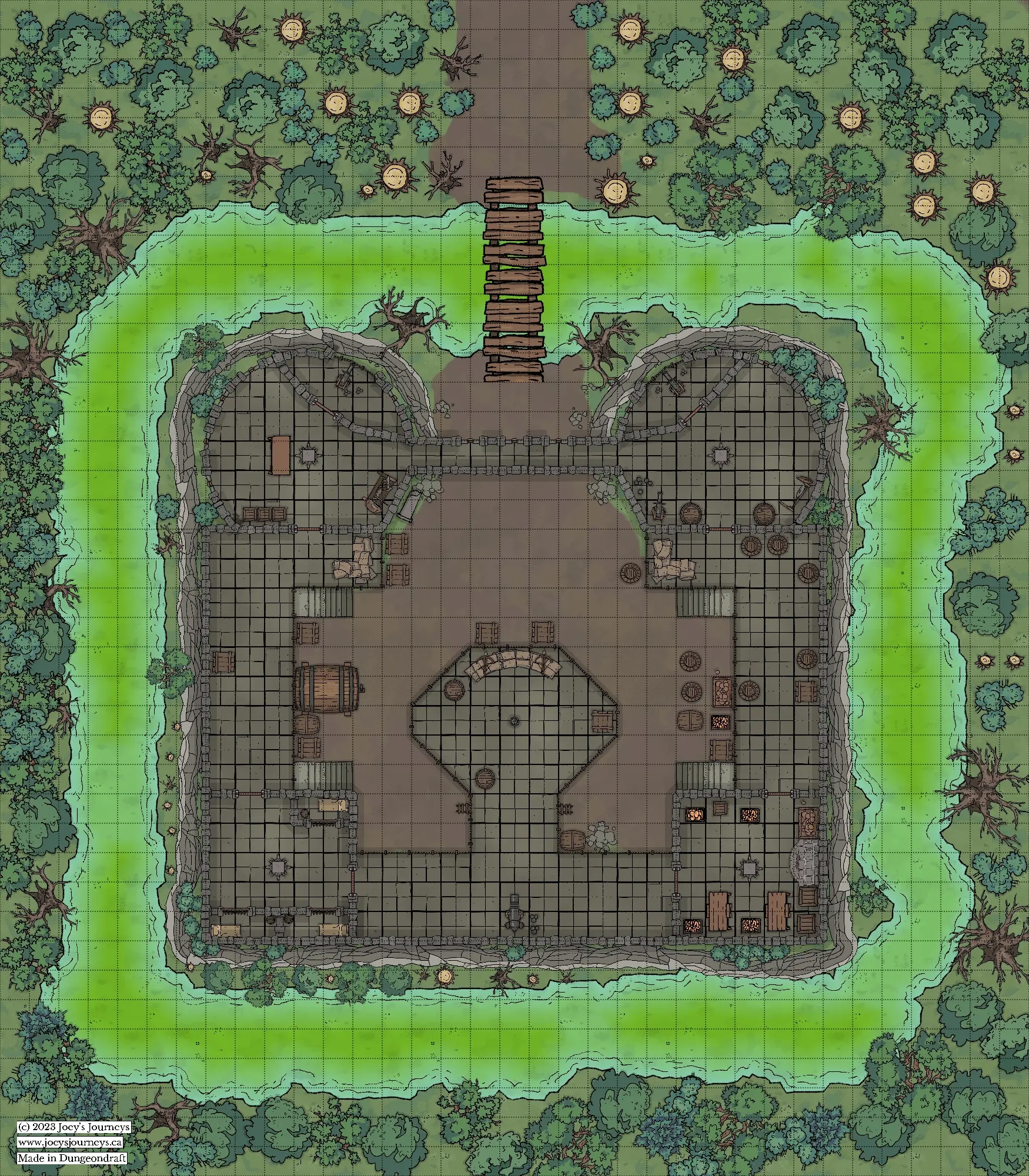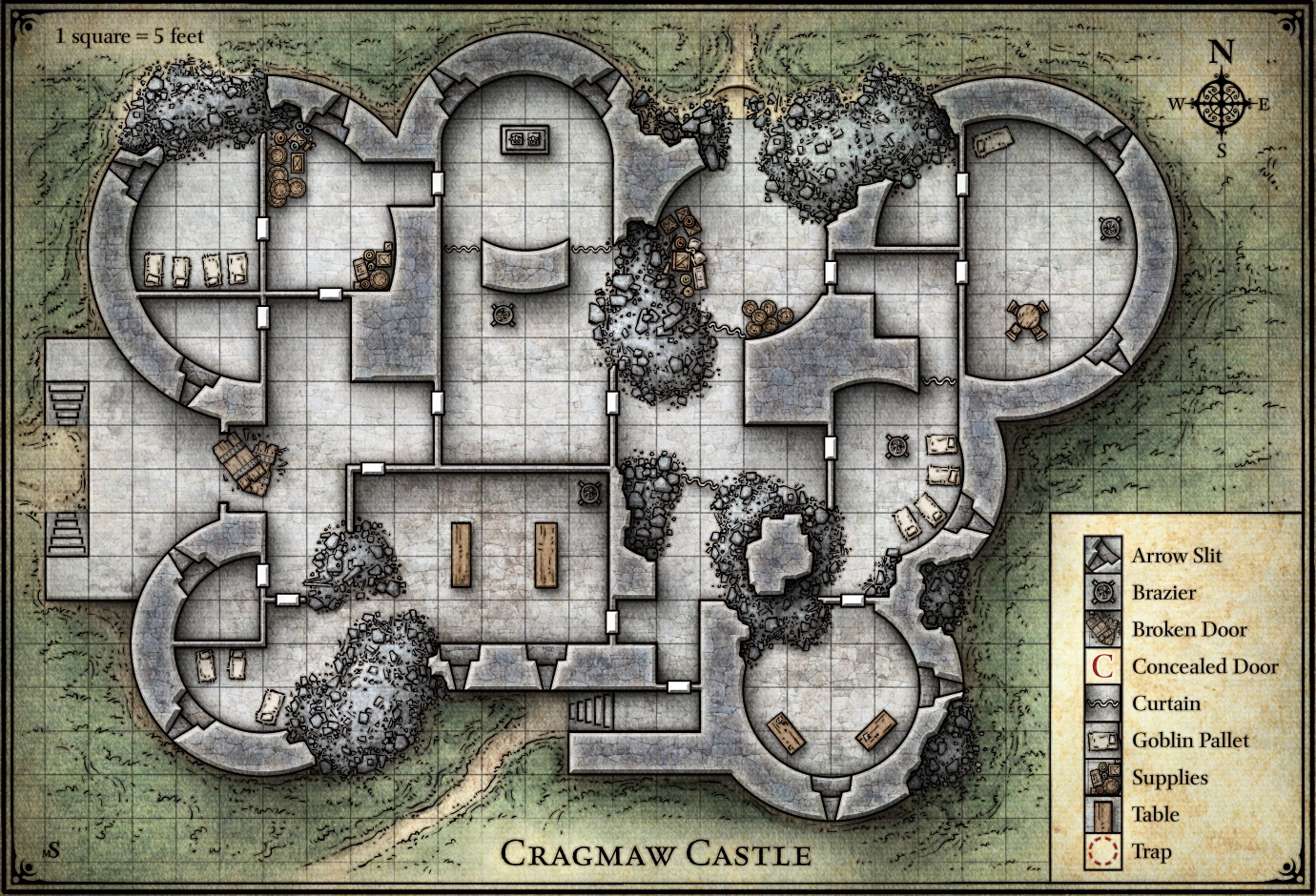
How could you imagine D&D without castles?
Fortified castles, fortresses and keeps are a classic D&D game mainstay in several homebrew games and published campaigns.
If you've ever embarked on a quest in the fantastical realms of Dungeons & Dragons, you know that the thrill of the journey is matched only by the depth of the dungeons themselves. Whether you're storming the gates as a brave hero or plotting your villain's lair as a Dungeon Master, D&D castle maps are like the blueprints to the epic tales that unfold around the table.
Let's dive headfirst into the art of designing castle maps for Dungeons & Dragons. It's time to use and make maps that will transport your players right into the heart of the action.
The Role of Castles & Castle Maps in D&D
From the towering walls, the cobbled courtyard, the ominous drawbridge – all of these elements come to life on a castle map.
Real-world castles have existed since over 2000+ BC. Take the Citadel of Aleppo in Syria for instance, designed well before European castles, many of which were constructed in the 11th-14th centuries. Unlike a villa or mansion, these fortresses were made primarily for military purposes.
Castle maps aren't just scribbled lines on dry-erase mats or pixels on a screen. A well-designed map sets up the stage and immerses the players and dungeon master, while visually guiding them through the adventure. In fact, castles have so much synergy with D&D that you can now actually book to play a game in one!
Castle maps have been popular in D&D for decades. Some mentions include:
Castle Waterdeep
Cragmaw Castle
Castle Ravenloft
Castle Never
How Castle Maps Enhance Role-Playing, Story & Strategy

Castles maps have many differences compared to cave maps. Castles are man-made structures, above ground (traditionally) and feature coveted military protection and defences such as impenetrable walls, towers for ranged attackers, a fortified gate, and a bridge for access.
Castles in D&D are used as a narrative device as well. For example, an occupied cave may be a discrete hideout for a group of bandits or monsters, but it would paint the picture of a small force. An invaded castle illustrates a powerful, immediate and dangerous threat to the players.
Brainstorming Infiltration Strategies
Imagine your players huddled around the map, deliberating over their approach to infiltrating the castle. Do they scale the walls, sneak through the dungeons, or confront the guards head-on at the front gate? The map becomes a canvas for tactical discussion, where plans are hatched, alliances are formed, and daring escapes are meticulously plotted.
With this blog's swamp D&D castle map, your players could have plenty of obstacles to consider including:
The Moat: is the water surrounding the castle safe? Is it water at all (maybe acid)? Are there hungry creatures awaiting their next meal?
Castle Walls: Towering worked stone walls wrap around the entire castle.
Front Gate: from two batteries on each tower to arrow slits and backup mounted crossbows, the players could have lots of resistance with a reckless approach.
Courtyard: The castle courtyard is barren and at a lower elevation to the platforms. Guards, bandits or whatever occupying force will have no trouble picking off players in this area.
Outer Forest: The forest surrounding the fort can be an opportunity to make a sneaky approach across the moat... It's up to you as a Dungeon Master if the woods are safe (or occupied by guards, awakened trees, or roaming monsters).
Essential Elements of Castle Maps

Creating a captivating castle map is like forging a key that unlocks a world of adventure and intrigue.
Note: If you’re new to designing maps, I’d highly recommend checking this D&D map-making guide I wrote to lay the groundwork for your game.
To summarize, you should pay attention to these 3 elements when designing and/or populating your D&D map.
Concept & Objective: Who built it, why, and what do players need to do?
Size & Progression: The number of rooms and intended order of completion.
Encounter Ideas: Big bad monsters, minions, traps, NPCs, etc.
To craft a map that truly comes to life, one must pay heed to the essential elements that make a castle a living, breathing dungeon. Let's delve into the key essentials that can transform a mere sketch into a sprawling fortress.
Exterior Layout

Walls, Gates, and Drawbridges
The fortress's outer shell is its first line of defence. The walls should reflect the castle's purpose and history – are they imposing stone barriers, weathered and battle-scarred, or elegant, with decorative embellishments?
Gates and drawbridges offer points of entry – are they massive iron portcullises, ornate wooden gates, or imposing stone archways?
Moats, Bridges, and Defensive Structures
Moats can be as vital to a castle's defence as its walls. Whether filled with water or left dry as a trench, a moat introduces strategic considerations that players must overcome.
Bridges spanning the moat can be chokepoints or scenes of dramatic showdowns. Defensive structures such as arrow towers, guard posts, and bastions provide not only tactical advantages but also architectural character.
Interior Layout
Keep, Towers, and Chambers

The castle's interior is a labyrinth of chambers, halls, and passageways.
The keep, often the heart of the castle, may house the lord's quarters, throne room, or treasure vault. Towers offer elevated vantage points and can serve as libraries, laboratories, or wizard's sanctums. Chambers vary widely, from feasting halls to intimate studies, each with its unique ambiance.
Dungeons, Secret Passages, and Hidden Rooms
Beneath the castle's surface may lie a realm of shadows and secrets.
Dungeons could house prisoners, forgotten creatures, or ancient relics. Secret passages wind through walls and beneath floors, offering covert routes - perhaps an escape path from invaders. Hidden rooms, concealed behind tapestries or triggered mechanisms, present opportunities for surprise encounters or concealed treasures.
Architectural Details

Furniture, Decorations, & Props
It's the little details that breathe life into a castle map. Furnishings like thrones, beds, and tables indicate the castle's inhabitants and their lifestyles. Decorations, such as banners, heraldry, and tapestries, add colour and narrative depth. Objects like lit braziers, scattered scrolls, and ornate chalices can set scenes and evoke atmosphere.
Trap Placements & Hazards:
Strategic trap placements can turn a hallway into a deathtrap or offer a defensive advantage. Hazards like crumbling walkways, hidden pitfalls, or poison vents create tension and force players to think on their feet.
Remember, each element you add to your castle map has the potential to spark intrigue, unravel stories, and ignite the imaginations of your players. Whether you're sketching with pencil and paper or deftly maneuvering digital tools, approach these essential elements with care – they're the building blocks of a castle that's destined to become a realm of legends.
Tips for Engaging Castle Map Experiences
Incorporating Interactive Elements
Levers, Switches, and Moving Parts
Infuse your castle map with a touch of magic by incorporating interactive elements. Levers that activate drawbridges, switches that reveal hidden passages, and mechanisms that move walls can add an element of surprise and excitement to your players' journey.
With the supplied map, perhaps the occupiers have rigged the rickety bridge to collapse with explosives or with a simple cannonball strike. A main door or portcullis could be installed, keeping the players out (or even trapping them in).
Note: Players may be able to use this castle as a base of operations later on, so they may install their own devices.
Varied Terrain & Elevation

Stairs, Ramps, and Multi-Level Designs:
Castles aren't flat – they're three-dimensional structures. Incorporate stairs, ramps, and multi-level designs to add complexity to your map. Varying elevations not only offer tactical advantages but also create opportunities for dramatic entrances, ambushes, and daring escapes.
In the provided map, notice how the courtyard with barrels and crates is lower than the surrounding walls. This was done simply with a few staircases and a pair of ladders on the south side.
Vertical Spaces For Dynamic Combat & Navigation:

Vertical spaces introduce a thrilling dimension to combat encounters. Archers firing from towers, rogues leaping between parapets, and wizards taking cover behind battlements – these scenarios foster dynamic combat tactics that keep players on their toes.
The two North gate towers will provide a challenge for players. The cannons are stationed on a separate balcony on each tower. Paired with the arrow slits, players will have to think of ways to avoid or distract many opponents with ranged attacks.
Adding Storyline Steaks: A Rescue Mission

Players need to be risking their lives infiltrating a castle for a good reason. Is a rival faction gaining too much ground and terrorizing the area? Maybe someone important is being held hostage or has been captured?
At the Southwest end of the provided castle map, there’s a small jail room. This can be a perfect place to put a noteworthy NPC - a player’s love interest, family member, or loyal contact - for a rescue mission. Adding this element will put a sense of urgency on the players to act and will add drama to your D&D game.
Want access to Even More Maps & DM Advice? Make Sure to Subscribe For More
I hope the above advice and the D&D castle map give you an inspiration point to plan for your next session.
What will you be using the map for? Are there any other elements that you prefer to add to a D&D castle map? Let me know in the comments!
Don’t forget to subscribe to the blog below to get more D&D insights, tips for DMs and Players, maps, and even access to unique D&D one-shot adventures in the future.
Consider becoming a Patron to support my ongoing quest to create amazing D&D content for your games.
